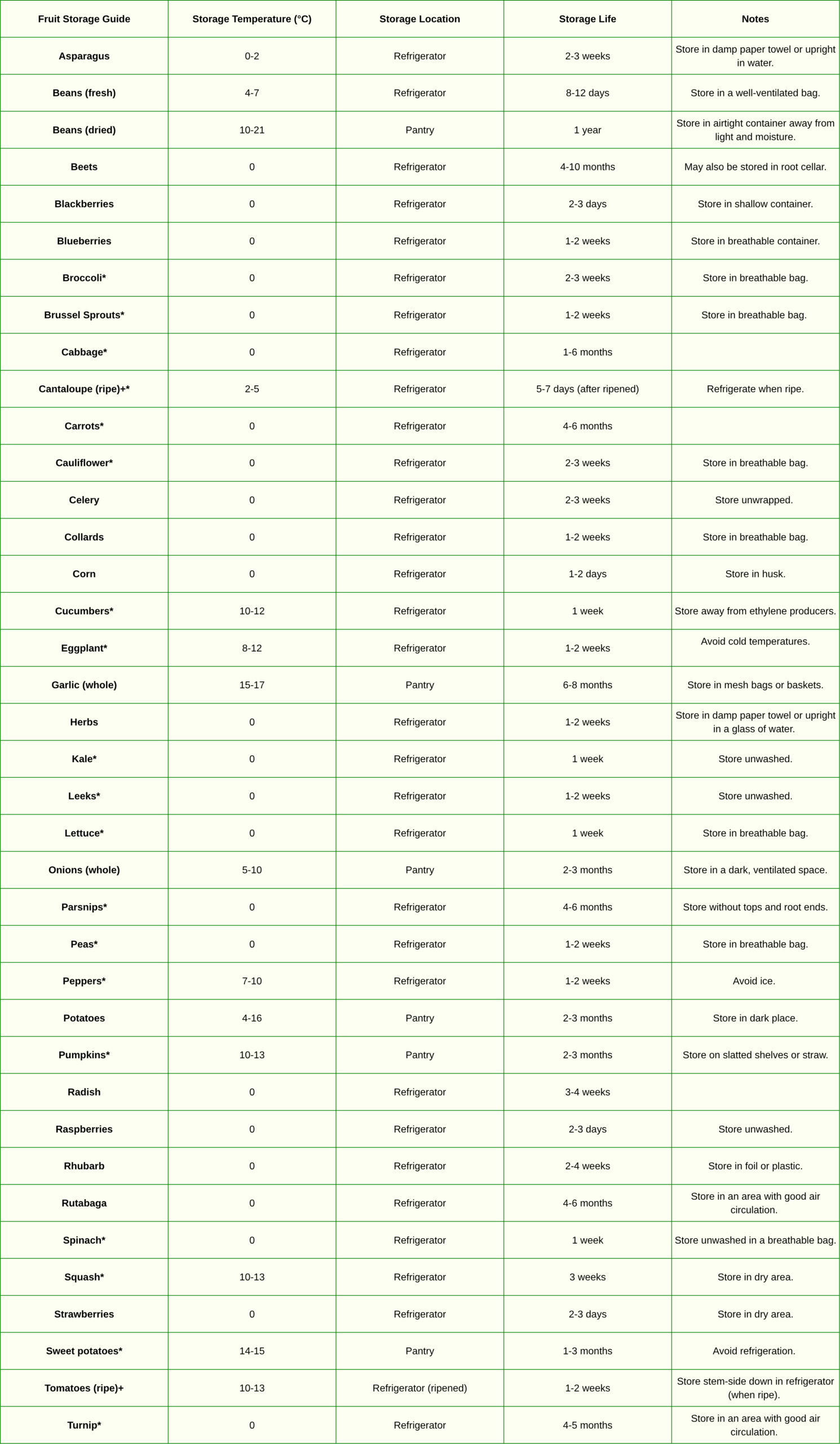HOME STORAGE GUIDE FOR FRESH FRUITS & VEGETABLES
(from the Canadian Produce Marketing Association; click here to download pdf)
Storage:
Proper and safe storage of fruit and vegetables at home is important for many reasons, including:
- Maintaining the integrity of the product
- Allowing certain fruits to continue ripening
- Preventing spoilage
- Preventing illness
- Maximizing the value of your purchasing dollar
Improper storage of some whole fresh fruits and vegetables may lead to:
- Loss of flavor
- Decline in nutrient content
A major determining factor in fruit and vegetable storage is ethylene gas. Ethylene gas is a natural gas produced by some fruits to promote the ripening process – particularly after harvesting. However, when ethylene producing fruits are stored near ethylene sensitive vegetables, it can accelerate spoilage and reduce shelf life. To prevent this, fruits and vegetables should be stored separately in the refrigerator. Refer to the chart below to identify which items produce ethylene and which are sensitive to it.
Tips:
- Store ethylene producing fruits away from ethylene-sensitive vegetables.
- Store vegetables in ideal conditions (dark, dry and cool) to prolong shelf life.
- Be cautious when storing large quantities of potatoes, onions, squash and rutabagas together, as improper conditions can lead to mass spoilage.
Ripening:
Unripen fruits and vegetables often taste bitter, so it is best to consume them once they have fully ripened. To do so, you can follow the following steps:
- Place fruit in a paper bag.
- Loosely close the bag to ensure there is air circulation.
- Leave the bag at room temperature but away from direct sunlight.
To check ripeness, place fruit in the palm of your hand and squeeze gently. If the fruit responds to light pressure and smells slightly sweet, it’s ready to eat! If not, leave it in the bag and check back daily.
Tips:
- Always use paper bags for ripening. Using plastic bags or containers can trap moisture and air that can lead to spoilage.
- Ripening rates vary depending on the type of fruit and room temperature. Be sure to check on the fruit daily for ripeness and refer to the chart below for more details.
- You can speed up the ripening process by adding a ripe banana or an apple (ethylene producers) to the bag.
- Once the fruit is ripe, store it in the refrigerator to slow the deterioration process and preserve its ideal flavour, aroma, texture and nutritional value.
Preparation:
Follow these simple steps to prepare fresh fruits and vegetables safely and effectively:
- Wash with clean, cool running water.
- Remove and discard wilted, discolored or blemished leaves.
- Carefully dry in a salad spinner or on clean paper towels.
- Store appropriately using the chart below.
Tips:
- Use clean cutting boards and utensils when preparing produce to avoid cross-contamination.
- Avoid washing fresh fruit and vegetables (with the exception of leafy greens) before storing. Many of them have a natural protective coating that prevents spoilage.
- Leafy greens (iceberg, romaine, Boston, bibb, green and red leaf lettuce and spinach) should not be cut before storing. Cutting exposes them to oxygen which can lead to pink/brown discoloration – a sign of deterioration.
- Once cut, fresh fruits and vegetables should be stored in a container in the refrigerator for no more than 2-3 days.
- Discard any cut produce which has been at room temperature for 2 or more hours.

